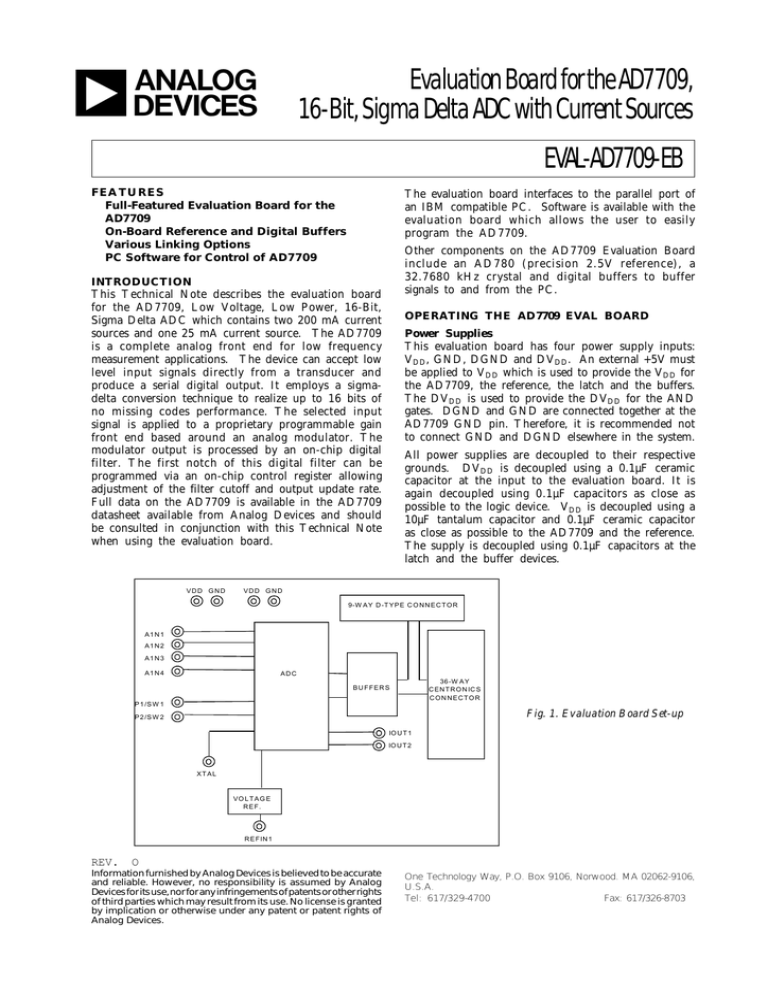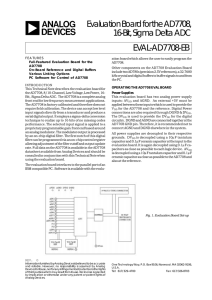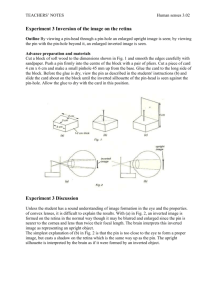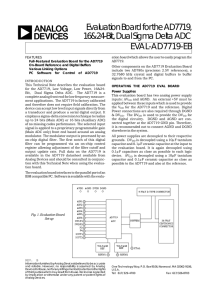a Evaluation Board for the AD7709, EVAL-AD7709-EB
advertisement

a Evaluation Board for the AD7709, 16-Bit, Sigma Delta ADC with Current Sources EVAL-AD7709-EB FEATURES Full-Featured Evaluation Board for the AD7709 On-Board Reference and Digital Buffers Various Linking Options PC Software for Control of AD7709 The evaluation board interfaces to the parallel port of an IBM compatible PC. Software is available with the evaluation board which allows the user to easily program the AD7709. Other components on the AD7709 Evaluation Board include an AD780 (precision 2.5V reference), a 32.7680 kHz crystal and digital buffers to buffer signals to and from the PC. INTRODUCTION This Technical Note describes the evaluation board for the AD7709, Low Voltage, Low Power, 16-Bit, Sigma Delta ADC which contains two 200 mA current sources and one 25 mA current source. The AD7709 is a complete analog front end for low frequency measurement applications. The device can accept low level input signals directly from a transducer and produce a serial digital output. It employs a sigmadelta conversion technique to realize up to 16 bits of no missing codes performance. The selected input signal is applied to a proprietary programmable gain front end based around an analog modulator. The modulator output is processed by an on-chip digital filter. The first notch of this digital filter can be programmed via an on-chip control register allowing adjustment of the filter cutoff and output update rate. Full data on the AD7709 is available in the AD7709 datasheet available from Analog Devices and should be consulted in conjunction with this Technical Note when using the evaluation board. VDD GND OPERATING THE AD7709 EVAL BOARD Power Supplies This evaluation board has four power supply inputs: VDD, GND, DGND and DVDD. An external +5V must be applied to VDD which is used to provide the VDD for the AD7709, the reference, the latch and the buffers. The DVDD is used to provide the DVDD for the AND gates. DGND and GND are connected together at the AD7709 GND pin. Therefore, it is recommended not to connect GND and DGND elsewhere in the system. All power supplies are decoupled to their respective grounds. DVDD is decoupled using a 0.1µF ceramic capacitor at the input to the evaluation board. It is again decoupled using 0.1µF capacitors as close as possible to the logic device. VDD is decoupled using a 10µF tantalum capacitor and 0.1µF ceramic capacitor as close as possible to the AD7709 and the reference. The supply is decoupled using 0.1µF capacitors at the latch and the buffer devices. VDD GND 9-W A Y D -T Y P E C O NN E C T O R A1N1 A1N2 A1N3 A1N4 ADC 36 -W A Y C EN T R O N IC S CON NECTOR B U F FE R S P 1 /S W 1 Fig. 1. Evaluation Board Set-up P 2 /S W 2 IO U T 1 IO U T 2 XT AL VO LTAG E R E F. R E FIN 1 REV. O Information furnished by Analog Devices is believed to be accurate and reliable. However, no responsibility is assumed by Analog Devices for its use, nor for any infringements of patents or other rights of third parties which may result from its use. No license is granted by implication or otherwise under any patent or patent rights of Analog Devices. One Technology Way, P.O. Box 9106, Norwood. MA 02062-9106, U.S.A. Tel: 617/329-4700 Fax: 617/326-8703 EVAL-AD7709-EB LINK AND SWITCH OPTIONS There are twelve link options which must be set for the required operating setup before using the evaluation board. The functions of these link options are outlined below. Link No. Function LK1-LK4 These links are in series with the AIN1 through AIN4 analog inputs respectively. With these links in place, the analog inputs on the relevant SKT input is connected directly to the respective AIN input on the part. For example, with LK1 in place, the analog input applied to SKT1 is connected directly to AIN1 of the AD7709. LK7&8 This option selects the master clock source for the AD7709. The master clock is generated by the on-board crystal or from an external source via SKT7. This is a double link and both links must be moved together for the correct operation of the evaluation board. With both links in position "A", the external clock option is selected and an external clock applied to SKT7 is routed to the XTAL1 pin of the AD7709. With both links in position "B", the on-board crystal is selected to provide the master clock to the AD7709. LK9 This link is used to select the reference source for the REFIN1(-) input of the AD7709. With this link in position "A", REFIN1(-) is connected directly to GND. With this link is position "B", LK10 open and links LK11, LK12 and LK13 closed, the reference can be generated via a 10KW resistor by enabling IOUT1. With this link in position "C", the REFIN1(-) is connected to SKT14. An external voltage applied to SKT14 can now be used as the REFIN1(-) for the AD7709. LK10 This link is used to select the reference source for the REFIN1(+) input of the AD7709. With this link in position "A", REFIN1(+) is connected to the output of the on-board reference (AD780 - U6). With this link in position "B", REFIN1(+) is connected to SKT15. An external voltage applied to SKT15 can now be used as the REFIN1(+) for the AD7709. With this link is position "C", REFIN1(+) is connected to VDD. When the current source IOUT1 is used to generate the reference via the 10KW resistor, LK10 is left open, LK9 is placed in position "B" and links LK11, LK12 and LK13 are closed. LK11-13 These links are used when REFIN1 is generated from current cource IOUT1. When these links are closed, LK9 is open and LK10 is in position B, IOUT1 is enabled to generate the current source. If another reference source is being used, LK11, LK12 and LK13 should be left open. LK14 Not used. SET-UP CONDITIONS Care should be taken before applying power and signals to the evaluation board to ensure that all link positions are as per the required operating mode. Table 1 shows the position in which all the links are set when the evaluation board is sent out. Table 1: Initial Link and Switch Positions Link No. LK1-LK4 Position IN Function Connects analog inputs from SKT1-SKT5 to the input pins AIN1-AIN4 of the AD7709. LK7&8 B Both links in position B to select the on-board crystal as the master clock for the AD7709. LK9 A This connects the REFIN1(-) input of the AD7709 to GND. LK10 A The on-board reference (U6) provides the reference voltage for the REFIN1(+) input of the AD7709. LK11-13 OUT LK14 IOUT1 is not used to generate the REFIN1 reference. Not used. -2- Rev. O EVAL-AD7709-EB EVALUATION BOARD INTERFACING Interfacing to the evaluation board is via either a 9-way d-type connector, J4 or a 36-way centronics connector, J1. The pin-out for the J4 connector is shown in Fig. 2 and its pin designations are given in Table 2. The pinout for the J1 connector is shown in Fig. 3 and its pin designations are given in Table 3. J1 is used to connect the evaluation board to the parallel (printer) port of a PC. Connection is via a standard printer cable. J4 is used to connect the evaluation to any other system. The evaluation board should be powered up before a cable is connected to either of these connectors. 1 2 6 3 7 4 8 5 9 Fig. 2: Pin Configuration for the 9-Way D-Type Connector, J4. Table 2.: J4 Pin Description 1 1 SCLK Serial Clock. The signal on this pin is buffered before being applied to the SCLK pin of the AD7709. 2 RDY Logic output. This is a buffered version of the signal on the AD7709 RDY pin 3 CS Chip Select. The signal on this pin is buffered before being applied to the CS pin on the AD7709. 4 RESET Reset Input. Data applied to this pin is buffered before being applied to the AD7709 RESET pin. 5 DIN Serial Data Input. Data applied to this pin is buffered before being applied to the AD7709 DIN pin. 6 DGND Ground reference point for the digital circuitry. Connects to the DGND plane on the Evaluation board. 7 DOUT Serial Data Output. This is a buffered version of the signal on the AD7709 DOUT pin. 8 DVDD Digital Supply Voltage. The voltage applied to this pin will supply the DVDD for the digital AND gates. 9 NC Not Connected. Note 1 An explanation of the AD7709 functions mentioned here is given in Table 3 below as part of the J1 pin descriptions. -3- Rev. O EVAL-AD7709-EB 18 1 36 19 Fig. 3: 36-way Centronics (SKT2) Pin Configuration Table 3: 36-Way Connector Pin Description 1 NC No Connect. This pin is not connected on the evaluation board. 2 DIN Serial Data Input. Data applied to this pin is buffered before being applied to the AD7709 DIN pin. Serial Data Input with serial data being written to the input shift register on the part. Data from this input shift register is transferred to the control registers, depending on the register selection bits of the Communications Register. 3 RESET Reset Input. The signal on this pin is buffered before being applied to the RESET pin of the AD7709. RESET is an active low input which resets the control logic, interface logic, digital filter and analog modulator of the part to power-on status. 4 CS Chip Select. The signal on this pin is buffered before being applied to the CS pin of the AD7709. CS is an active low Logic Input used to select the AD7709. With this input hard-wired low, the AD7709 can operate in its three-wire interface mode with SCLK, DIN and DOUT used to interface to the device. CS can be used to select the device in systems with more than one device on the serial bus or as a frame synchronization signal in communicating with the AD7709. 5 SCLK Serial Clock. The signal on this pin is buffered before being applied to the SCLK pin of the AD7709. An external serial clock is applied to this input to read/write serial data from/to the AD7709. This serial clock can be continuous with all data transmitted in a continuous train of pulses. Alternatively, it can be non-continuous with the information being transmitted to the AD7709 in smaller batches of data. 6-8 NC No Connect. These pins are not connected on the evaluation board. 9 DVDD Digital Supply Voltage. This provides the supply voltage for the chip U4, which buffers the signals from the AD7709 to J1/J4. 10 RDY Logic output. This is a buffered version of the signal on the AD7709 RDY pin. A logic low on this output indicates that the ADC has valid data in its data register. The RDY pin will return high upon completion of a read operation of a full output word. If data is not read, RDY will return high prior to the next update indicating to the user that a read operation should not be initiated. The RDY pin has the same functionality as the bit in the Status register but it has the opposite polarity. 11-12 NC No Connect. These pins are not connected on the evaluation board. 13 DOUT Serial Data Output. This is a buffered version of the signal on the Serial Data Output with serial data obtained from the output AD7709. The output shift register can contain information from depending on the register selection bits of the Communications 14-18 NC No Connect. These pins are not connected on the evaluation board. 19-30 DGND Ground reference point for digital circuitry. Connects to the DGND plane on the evaluation board. 31-36 NC No Connect. These pins are not connected on the evaluation board. AD7709 DOUT pin. shift register on the the on-chip registers Register. SOCKETS There are eighteen sockets relevant to the operation of the AD7709 on this evaluation board. The functions of these sockets are outlined in Table 4. -4- Rev. O EVAL-AD7709-EB Table 4. Socket Functions CONNECTORS Socket Function There are four connectors on the AD7709 evaluation board as outlined in Table 5. SKT1 Sub-Miniature BNC (SMB) Connector. The analog input signal for the AIN1 input of the AD7709 is applied to this socket. Table 5. SKT2 Sub-Miniature BNC (SMB) Connector. The analog input signal for the AIN2 input of the AD7709 is applied to this socket. J1 36-way centronics connector used to interface to PC via parallel printer port. J2 SKT3 Sub-Miniature BNC (SMB) Connector. The analog input signal for the AIN3 input of the AD7709 is applied to this socket. PCB Mounting Terminal Block. The Analog Power Supply to the Evaluation Board must be provided via this Connector. J3 Sub-Miniature BNC (SMB) Connector. The analog input signal for the AIN4 input of the AD7709 is applied to this socket. PCB Mounting Terminal Block. The Digital Power Supply to the Evaluation Board must be provided via this Connector. J4 9-way D-Type connector used to interface to other systems. SKT4 SKT7 Sub-Miniature BNC (SMB) Connector. The master clock signal for the XTAL1 input of the AD7709 is applied to this socket when the board is configured for an externally applied master clock.The AD7709 can be operated with internal clock frequencies in the range 32.768 kHz +/10%. SKT8 Sub-Miniature BNC (SMB) Connector. The output value from AD7709 output pin P1/SW1 is available from this socket. SKT9 Sub-Miniature BNC (SMB) Connector. The output value from AD7709 output pin P2/SW2 is available from this socket. SKT10 Sub-Miniature BNC (SMB) Connector. The reference voltage for the REFIN2(+) input of the AD7709 is applied to this socket when the board is configured for an externally applied reference voltage. SKT11 Sub-Miniature BNC (SMB) Connector. The output value from AD7709 output pin IOUT2 is available from this socket. SKT12 Sub-Miniature BNC (SMB) Connector. The output value from AD7709 output pin IOUT1 is available from this socket. SKT14 Sub-Miniature BNC (SMB) Connector. The reference voltage for the REFIN1(-) input of the AD7709 is applied to this socket when the board is configured for an externally applied reference voltage. SKT15 Sub-Miniature BNC (SMB) Connector. The reference voltage for the REFIN1(+) input of the AD7709 is applied to this socket when the board is configured for an externally applied reference voltage. SKT16 Not used. Connector Functions Connector -5- Functions Rev. O EVAL-AD7709-EB SWITCHES There is one switch on the AD7709 Evaluation board. SW1 is a push-button reset switch. Pushing this switch activates the active low RESET input on the AD7709 which resets the control logic, interface logic, calibration coefficients, digital filter and analog modulator of the part to power-on status. AD7709 SOFTWARE DESCRIPTION The AD7709 evaluation board is shipped with a CD-ROM containing software that can be installed onto a standard PC to control the AD7709. The software uses the printer port of the PC to communicate with the AD7709, so a Centronics printer cable is used to connect the PC to the evaluation board. Software Requirements and Installation The software runs under Windows ME 2000 NT™ and typically requires 8Mb of RAM. To install the software the user should start Windows and insert the CD-ROM disc. The installation software should launch automatically. It not, use Windows Explorer to locate the file 'setup.exe' on the CD-ROM. Double clicking on this file will start the installation procedure. The user is prompted for a destination directory which is "C:\Program Files\Analog Devices\AD7709" by default. Once the directory has been selected the installation procedure will copy the files into the relevant directories on the hard drive. The installation program will create a Program Group called "Analog Devices" with sub-group 'AD7709' in the "Start" taskbar. Once the installation procedure is complete the user can double click on the AD7709 icon to start the program. Features of the Software 1. The software will allow the user to write to and read from all the registers of the AD7709. 2. Data can be read from the AD7709 and displayed or stored for later analysis. 3. The data that has been read can be exported to other packages such as Mathcad or Excel for further analysis. -6- Rev. O EVAL-AD7709-EB What follows is a description of the various windows that appear while the software is being used. Fig. 4. shows the main screen that appears once the program has started. A brief description of each of the dropdown menus on the main screen follows: File Allows the user to read in previously stored data for display or analysis or write the current set of data to a file for later use. This button also allows the user to exit the program. Registers Allows the user to program or read the on-chip registers of the AD7709. Noise Analysis Allows the user to perform noise analysis on the data that has been read in from the ADC. Standby Options Allows the user to power up and power down the AD7709. When the device is powered down, the powering down of the oscillator is optional. Reset AD7709 Allows the user to perform a software or hardware reset on the AD7709. Printer Port The printer port that will be used by the software is determined automatically. There are three possible printer ports that can be handled by the software, LPT1 (standard), LPT2 and PRN. The user can change to another printer port by clicking on the 'Printer Port' dropdown menu. Window Indicates which windows in the program are open. Help Provides information about the version of software being used. Fig. 4. The Main -7- Screen Rev. O EVAL-AD7709-EB Fig. 5. The Program AD7709 Screen The Registers AD7709 Screen Fig. 5. shows the screen that appears when the 'Registers' pulldown menu is selected. This menu allows the user to select which register is to be programmed. Fig. 6. The Filter Register Screen The Filter Register Screen Fig. 6. shows the Filter Register screen. When the screen is loaded the software will read the current contents from the Filter Register of the AD7709 and change the display accordingly. The Filter register is used to change the update rate of the AD7709, the allowable range for the word written to the Filter Register is 13(dec) to 255(dec) or 0D(Hex) to FF(Hex). The user can enter the filter word in Hex values in the text boxes provided. The user should consult the datasheets for more information on the use of the Filter Register. -8- Rev. O EVAL-AD7709-EB Fig. 7. The Configuration AD7709 Screen The ADC Configuration Register Screen Fig. 7. shows the ADC Configuration Register Screen. This register controls Bipolar/Unipolar operation, Channel selection, Range selection and allows the user to control the I/O ports P1 to P4 for the ADC. When the screen is loaded the software reads the current contents from the ADC Configuration Register of the AD7709 and sets the buttons accordingly. P1 and P2 can be used as power switches or as digital outputs. The user can program them as required. Note a 'high' represents a 5V output on the pin, 'low' represents GND. P3 and P4 can be configured as analog inputs or digital inputs. When programmed as digital inputs, the user can read in the value at the inputs P3 & P4. Everytime a change is made, the software writes the new conditions to the AD7709 and then reads back from the ADC Configuration Register for conformation. Pressing the refresh button will read the current contents of the Configuration register. Fig. 8. The Status Register The Status Register Screen Fig. 8. shows the Status Register Screen. When the screen is loaded the software reads the current contents from the Status Register of the AD7709 and sets the buttons accordingly. This is a read-only register and flags the operating conditions of the AD7709 such as data ready or ADC Error. Refer to AD7709 datasheet for more information. -9- Rev. O EVAL-AD7709-EB Fig. 12. The Read Data from Main ADC Screen Fig. 9. The ADC Noise Analysis Screen The Read Data from ADC Screen Fig. 9. shows the ADC Read Data screen and shows the pulldown menus needed to access it. This is where the user can read a number of samples from the AD7709 ADC. The user has the option of either reading data for analysis or display. When the Read For Analysis option is selected the software will read the required number of samples from the AD7709 ADC and store them in an array so that they can be graphed or analysed later. It is possible to read and graph up to 5000 samples at any one time. The read can be interrupted with a user key press. When the Read for Display option is selected the software will read one sample from the AD7709 and display its value in the Current Code text box. The software will continue to read and display the samples until a key has been pressed. It is possible to add a delay to the read cycle by entering the required number of milliseconds between reading samples. It should be noted however that the accuracy of the time delay can be affected by other programs running under Windows, therefore this method is not suitable where equidistant sampling is required. The Noise Analysis Screen Once data has been read from the AD7709 ADC, it is possible to perform some analysis on it. Fig. 10 shows the ADC Noise Analysis Screen. This screen displays the maximum and minimum codes read from the AD7709 ADC (in decimal and hexadecimal), as well as the average code, the average value and the RMS and Peak-Peak noise values. From this screen it is possible to display the data on a graph or as a histogram of codes. Figures 11 & 12 show the Graph and Histogram screens. - 10 - Rev. O EVAL-AD7709-EB Fig. 10. The ADC Noise Analysis Screen The Graph Screen Fig. 11 shows the Graph Screen. This screen displays the data in a graph format. Fig. 11. The Graph Screen - 11 - Rev. O EVAL-AD7709-EB Fig. 12. The Histogram Screen - 12 - Rev. O EVAL-AD7709-EB Fig. 13. The Evaluation Board Schematic - 13 - Rev. O EVAL-AD7709-EB Table 6. Component Listing and Manufacturers INTEGRATED CIRCUITS Component Location Vendor AD7709 U1 Analog Devices AD780AN U6 Analog Devices 74HC4050N U3 Philips 74C08SMD U4 Texas Instruments 74ACT244 U5 Fairchild Semiconductor SD103C D1/D2 ITT Component Location Vendor 10µF ± 20% Tantalum (16 V) C12 C17 C20 C23 AVX-Kyocera 0.1µF Ceramic (0805 SMD) C1-C6 C9-C11 C16 C18 C21 C22 CAPACITORS Mftrs No. TAG106MO16 FEC No. 499-768 RESISTORS Component Location Vendor Short Circuits R1-R5 Bourns 10kW ±5% 0.25W Carbon Film R7-R10 Bourns 3kW ±5% 0.25W Carbon Film Bourns R12 LINK OPTIONS Component Location Pin Headers Lk1-Lk4 Lk11-Lk13 Vendor (1x2 way) Harwin Mftrs No. M20-9983606 Lk7 Lk8 (2x2 way) Lk9 Lk10 Shorting Plugs (3x2 way) Pin Headers (15 required) Harwin Mftrs No. M7571-05 Component Location Vendor Sealed Push Button Switch SW1 Omron Mftrs No. B3W1000 Component Location Vendor Miniature BNC Connectors SKT1-SKT16 M/A - Com Greenpar Mftrs No. B65N07G999X99 9-Way D-Type Connector J4 McMurdo Mftrs No. SDE9PNTD 36 Way Centronics Connector J1 Fujitsu Mftrs No. FCN785J036G0 2 Way Terminal Block J2 J3 Bulgin RIA SWITCH SOCKETS - 14 - Rev. O EVAL-AD7709-EB Low profile socket U2,U3,U6 Harwin (32 pins needed) Farnell No. 519-959 Component Location Vendor 32.768 kHz Oscillator Xtal 1 IQD FEC No. 221-533 CRYSTAL OSCILLATOR Fig. 14. The Evaluation Board Component Layout Diagram - 15 - Rev. O EVAL-AD7709-EB Fig. 15. The Evaluation Board Component Side Artwork Fig. 16. The Evaluation Board SolderSide Artwork - 16 - Rev. O





